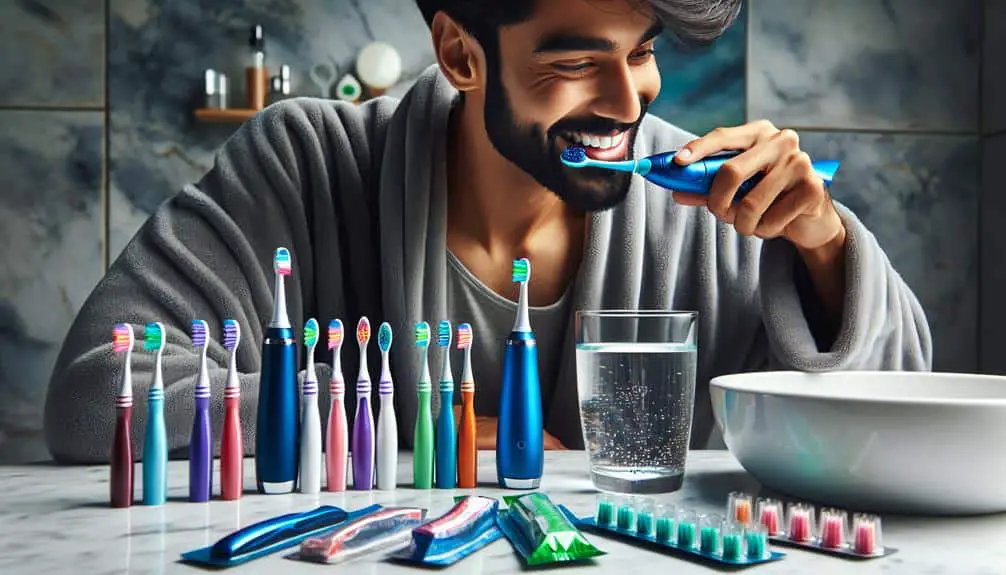To keep your teeth white after whitening treatment, stick to a daily oral hygiene routine with a soft toothbrush and fluoride toothpaste. Brush gently in circular motions for two minutes, floss daily, and rinse with mouthwash. Watch your diet by avoiding sugary and acidic foods, and visit your dentist regularly for cleanings and check-ups. Consider a whitening toothpaste and stay away from tobacco. By following these tips, you can maintain your bright smile effortlessly.
Key Points
- Maintain daily oral hygiene routine with gentle brushing and flossing.
- Limit consumption of staining foods and drinks.
- Use whitening toothpaste for regular stain removal.
- Attend regular dental check-ups for professional cleanings.
- Avoid tobacco and smoking to prevent teeth discoloration.
Daily Oral Hygiene Practices
To maintain your white teeth after a whitening treatment, establish a consistent daily oral hygiene routine that includes proper brushing, flossing, and using mouthwash. Proper brushing involves using a soft-bristled toothbrush and fluoride toothpaste. Brush your teeth gently in circular motions for at least two minutes, ensuring you reach all surfaces of your teeth. Flossing is important to remove plaque and food particles from between your teeth that brushing alone can't reach. Make it a habit to floss at least once a day. Additionally, using an antiseptic mouthwash can help kill bacteria and freshen your breath.
In addition to daily oral care, maintaining healthy dietary habits is essential for preserving your white smile. Limit sugary and acidic foods and drinks that can erode enamel and cause staining. Regular dental visits are necessary for professional cleanings and check-ups to address any issues promptly. By following these practices, you can prolong the effects of your whitening treatment and keep your teeth bright and healthy.
Limit Staining Foods and Drinks
Restricting your consumption of staining foods and drinks is essential for maintaining the whiteness of your teeth after a whitening treatment. Foods and beverages such as coffee, tea, red wine, berries, and tomato sauce contain pigments that can easily stain your teeth, undoing the effects of the whitening treatment. To protect your newly brightened smile, consider moderating your intake of these items. If you do consume them, using a straw can help minimize contact with your teeth.
Moreover, remember to brush your teeth or rinse your mouth with water after consuming staining foods to prevent the pigments from clinging to your enamel. This simple practice can go a long way in maintaining the results of your whitening treatment. Additionally, incorporating enamel-strengthening foods like dairy products and crunchy fruits and vegetables into your diet can aid in enamel protection, further safeguarding your teeth's whiteness. By being mindful of your diet and making small adjustments, you can prolong the effects of your whitening treatment, reducing the need for frequent whitening touch-ups.
Regular Dental Check-Ups
Routine dental check-ups are essential for preserving the health and brightness of your teeth after a whitening treatment. These check-ups play an important role in maintaining your oral health by allowing your dentist to detect and address any issues early on, preventing more significant problems in the future. The importance of prevention can't be overstated, as regular examinations help monitor the condition of your teeth and gums post-whitening, ensuring that any concerns are promptly managed.
In addition to check-ups, dental cleaning schedules are key for keeping your teeth white and healthy. Professional cleanings help remove plaque and tartar buildup that can diminish the effects of whitening treatments and lead to discoloration over time. Your dentist can recommend a cleaning routine tailored to your specific needs and the type of whitening treatment you've undergone. By following these schedules diligently, you can prolong the results of your whitening treatment and maintain a bright, healthy smile for longer.
Use Whitening Toothpaste
Consider incorporating a whitening toothpaste into your daily oral care routine to help maintain the brightness of your teeth post-whitening treatment. Whitening toothpaste is formulated to gently polish away surface stains, preventing them from settling and causing discoloration. These toothpaste varieties often contain mild abrasives or polishing agents that can help in removing stains accumulated from food and drinks. Additionally, whitening toothpaste can assist in preventing the buildup of new stains, prolonging the effects of your whitening treatment.
When selecting a whitening toothpaste, look for one that addresses tooth sensitivity and provides enamel protection. Some whitening toothpaste options are designed with ingredients that cater to individuals with sensitive teeth, ensuring a comfortable whitening experience. Furthermore, choose a toothpaste that helps strengthen and protect your enamel, as this outer layer safeguards your teeth from decay and damage. By incorporating a quality whitening toothpaste into your daily routine, you can maintain your bright smile while promoting overall oral health.
Avoid Tobacco and Smoking
To maintain the brightness of your teeth post-whitening treatment, it's imperative to steer clear of tobacco and smoking, as these habits can severely stain and discolor your teeth over time. Smoking not only poses risks to your overall health but also greatly impacts the color of your teeth, undoing the effects of any whitening treatment.
Here are some key points to keep in mind:
- Tobacco and smoking are major culprits in causing teeth discoloration.
- Nicotine and tar in tobacco can lead to stubborn stains on your teeth.
- Quitting smoking can't only preserve your white smile but also improve your oral and overall health.
- Adopting healthy habits like regular brushing, flossing, and dental check-ups can further aid in preventing discoloration and maintaining the results of your whitening treatment.
Frequently Asked Questions
Can I Use Whitening Strips or Trays After Getting a Professional Whitening Treatment?
You can typically use whitening strips or trays after professional treatment, but it's best to consult your dentist first. While these at-home methods can enhance results, make sure they won't compromise your teeth's health or the professional whitening's efficacy.
How Soon Can I Eat or Drink After a Whitening Treatment?
After a whitening treatment, wait at least 30 minutes before eating to allow your teeth to settle. Avoid consuming dark liquids like coffee or red wine immediately after. Opt for water or clear beverages to maintain your bright smile longer.
Are There Any Natural Remedies or DIY Methods to Maintain White Teeth After Whitening?
To maintain white teeth after whitening, try natural remedies like oil pulling or baking soda paste, and DIY methods such as hydrogen peroxide rinses. Consistent use of these home whitening techniques alongside good oral care maintenance can enhance results.
Can I Still Use a Regular Toothpaste in Addition to a Whitening Toothpaste?
Yes, you can use a regular toothpaste along with a whitening toothpaste. It's essential for maintaining good oral hygiene. Combining both can help enhance whitening results and maintain the effectiveness of the whitening treatment over time.
How Often Should I Touch up My Whitening Treatment to Maintain White Teeth?
To maintain white teeth after whitening, touch up every 6-12 months for best results. Adopt good oral habits like regular brushing, flossing, and avoiding stain-inducing foods. Consistent care will help prolong the effects of your whitening treatment.


